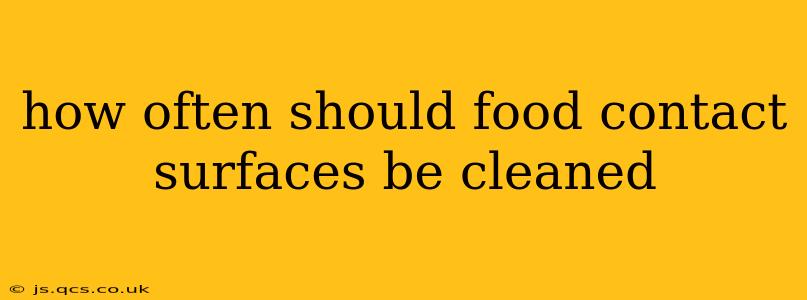Maintaining a clean and sanitary kitchen is crucial for preventing foodborne illnesses. Understanding how often to clean food contact surfaces is vital, both for home cooks and food service establishments. While there's no single magic number, the frequency depends on several factors, including the type of surface, the food being prepared, and the level of use. Let's delve into the specifics.
What are considered food contact surfaces?
Before we discuss cleaning frequency, it's important to define what constitutes a food contact surface. These are any surfaces that come into direct contact with food during preparation, processing, or storage. This includes:
- Cutting boards: Wooden, plastic, or other materials used for chopping, slicing, and dicing.
- Countertops: Work surfaces where food preparation occurs.
- Utensils: Knives, spoons, spatulas, and other tools used in cooking.
- Dishes and plates: Used for serving and eating food.
- Mixing bowls: Used for combining ingredients.
- Food preparation equipment: Meat grinders, slicers, blenders, etc.
Essentially, if food touches it, it's a food contact surface and requires regular cleaning.
How Often Should Food Contact Surfaces Be Cleaned? A Practical Approach
The general rule is to clean and sanitize food contact surfaces after each use. This is especially critical after handling raw meat, poultry, seafood, or eggs. Cross-contamination is a major cause of foodborne illness, and thorough cleaning prevents the spread of harmful bacteria.
However, some surfaces might require more frequent attention depending on their use:
- Cutting boards: Should be cleaned and sanitized after each use, especially if used for raw meat. Ideally, have separate cutting boards for raw and cooked foods.
- Countertops: Wipe down with a sanitizing solution after preparing each meal or anytime spills or splatters occur.
- Utensils: Wash thoroughly with hot, soapy water after each use, and sanitize when necessary (especially those used with raw meats).
- Dishes and plates: Wash thoroughly in hot, soapy water after each meal. Dishwashers are ideal for sanitization.
What about less frequent cleaning?
While daily cleaning is a must for food contact surfaces, deeper cleaning should be performed less frequently, depending on the surface and level of use. This usually involves a more thorough cleaning with degreasers and disinfectants.
- Deep Cleaning frequency: Consider deep cleaning weekly, or even bi-weekly, for most kitchen surfaces. This includes scrubbing with a more powerful cleaner, paying attention to corners, crevices, and areas where food particles may accumulate.
What Cleaning and Sanitizing Methods Should I Use?
The best cleaning method depends on the surface material. Always refer to the manufacturer's instructions for cleaning specific materials. However, generally:
- Washing with hot, soapy water: This is an effective first step for removing food residue. Use hot water (at least 120°F) and a detergent designed for food contact surfaces.
- Sanitizing: After washing, sanitize surfaces to kill any remaining bacteria. You can use commercial sanitizers, a bleach solution (1 tablespoon of bleach per gallon of water), or white vinegar (diluted with water). Allow the sanitizer to sit on the surface for the recommended time before rinsing thoroughly.
How to Properly Clean and Sanitize Food Contact Surfaces?
Cleaning and sanitizing food contact surfaces are two separate but essential steps:
- Cleaning: First, remove all visible food residue using hot, soapy water and a clean cloth or sponge. Scrape off stuck-on food before washing. Rinse thoroughly.
- Sanitizing: After cleaning, apply a sanitizing solution as per the instructions on the label. Allow the solution to contact the surface for the recommended time before rinsing with clean water. Thoroughly dry surfaces using clean paper towels or allow them to air dry.
What are the risks of not cleaning food contact surfaces properly?
Improper cleaning of food contact surfaces significantly increases the risk of cross-contamination and foodborne illnesses. Bacteria, viruses, and parasites can easily transfer from raw foods to cooked foods, causing various health problems.
What are some common foodborne illnesses?
Foodborne illnesses are caused by contaminated food and water and can lead to a variety of unpleasant and potentially serious health issues. Some of the most common include:
- Salmonella: Often associated with poultry, eggs, and contaminated produce.
- E. coli: Primarily found in undercooked ground beef, contaminated produce, and unpasteurized milk.
- Listeria: Can contaminate soft cheeses, ready-to-eat meats, and unpasteurized milk.
- Norovirus: A highly contagious virus often spread through contaminated food or surfaces.
By following these guidelines and prioritizing food safety, you can significantly reduce the risk of foodborne illnesses and ensure a healthy kitchen environment. Remember, consistent cleaning is key to maintaining a safe and hygienic kitchen.
